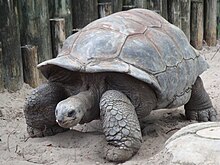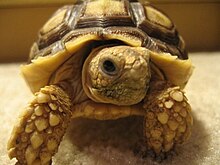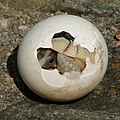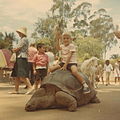Tortoise
| Tortoises | |
|---|---|
 | |
Aldabra giant tortoise (Aldabrachelys gigantea) | |
Scientific classification | |
| Kingdom: | Animalia |
| Phylum: | Chordata |
| Class: | Reptilia |
| Order: | Testudines |
| Suborder: | Cryptodira |
| Superfamily: | Testudinoidea |
| Family: | Testudinidae Batsch, 1788 |
Type species | |
Testudo graeca Linnaeus, 1758 | |
Tortoises (/ˈtɔːr.təs.ɪz/) are a family, Testudinidae, under the order Testudines and suborder Cryptodira. There are fourteen extant families of the order Testudines, an order of reptile commonly known as turtles, tortoises, and terrapins. The suborder Cryptodira (Greek: hidden neck) is a suborder of Testudines that includes most living tortoises and turtles. Cryptodira differ from Pluerodia (side-neck turtles) in that they lower their necks and pull the heads straight back into the shells, instead of folding their necks sideways along the body under the shells' marginals. The testudines are some of the most ancient reptiles alive. Tortoises are shielded from predators by a shell. The top part of the shell is the carapace, the underside is the plastron, and the two are connected by the bridge.
The carapace is fused to both the vertebrae and ribcage, and tortoises are unique among vertebrates in that the pectoral and pelvic girdles are inside the ribcage rather than outside. Tortoises can vary in dimension from a few centimeters to two meters. They are usually diurnal animals with tendencies to be crepuscular depending on the ambient temperatures. They are generally reclusive animals. Tortoises are the longest living land animal in the world, although the longest living species of tortoise is a matter of debate. Galápagos tortoises are noted to live over 150 years, but an Aldabra giant tortoise named Adwaita may have been the longest living at an estimated 255 years. In general, most tortoise species can live 80–150 years.
Contents
1 Terminology
2 Biology
2.1 Lifecycle
2.2 Sexual dimorphism
2.3 Brain
3 General information
4 Diet
5 Taxonomy
6 In religion
7 Gallery
8 See also
9 References
10 Further reading
11 External links
Terminology
Differences exist in usage of the common terms turtle, tortoise, and terrapin, depending on the variety of English being used; usage is inconsistent and contradictory.[1] These terms are common names and do not reflect precise biological or taxonomic distinctions.[2]

Tile with two rabbits, two snakes, and a tortoise, illustration for Zakariya al-Qazwini's book, Iran, 19th century
The American Society of Ichthyologists and Herpetologists uses "turtle" to describe all species of the order Testudines, regardless of whether they are land-dwelling or sea-dwelling, and uses "tortoise" as a more specific term for slow-moving terrestrial species.[1] General American usage agrees; turtle is often a general term (although some restrict it to aquatic turtles); tortoise is used only in reference to terrestrial turtles or, more narrowly, only those members of Testudinidae, the family of modern land tortoises; and terrapin may refer to turtles that are small and live in fresh and brackish water, in particular the diamondback terrapin (Malaclemys terrapin).[3][4][5][6] In America, for example, the members of the genus Terrapene dwell on land, yet are referred to as box turtles rather than tortoises.[2]
British usage, by contrast, tends not to use "turtle" as a generic term for all members of the order, and also applies the term "tortoises" broadly to all land-dwelling members of the order Testudines, regardless of whether they are actually members of the family Testudinidae.[6] In Britain, terrapin is used to refer to a larger group of semiaquatic turtles than the restricted meaning in America.[4][7]
Australian usage is different from both American and British usage.[6] Land tortoises are not native to Australia, yet traditionally freshwater turtles have been called "tortoises" in Australia.[8] Some Australian experts disapprove of this usage—believing that the term tortoises is "better confined to purely terrestrial animals with very different habits and needs, none of which are found in this country"—and promote the use of the term "freshwater turtle" to describe Australia's primarily aquatic members of the order Testudines because it avoids misleading use of the word "tortoise" and also is a useful distinction from marine turtles.[8]
Biology
Lifecycle

Adult male leopard tortoise, South Africa

Young African sulcata tortoise
Most species of tortoises lay small clutch sizes, seldom exceeding 20 eggs, and many species have clutch sizes of only 1–2 eggs. Incubation is characteristically long in most species, the average incubation period are between 100 and 160 days. Egg-laying typically occurs at night, after which the mother tortoise covers her clutch with sand, soil, and organic material. The eggs are left unattended, and depending on the species, take from 60 to 120 days to incubate.[9] The size of the egg depends on the size of the mother and can be estimated by examining the width of the cloacal opening between the carapace and plastron. The plastron of a female tortoise often has a noticeable V-shaped notch below the tail which facilitates passing the eggs. Upon completion of the incubation period, a fully formed hatchling uses an egg tooth to break out of its shell. It digs to the surface of the nest and begins a life of survival on its own. They are hatched with an embryonic egg sac which serves as a source of nutrition for the first three to seven days until they have the strength and mobility to find food. Juvenile tortoises often require a different balance of nutrients than adults, so may eat foods which a more mature tortoise would not. For example, the young of a strictly herbivorous species commonly will consume worms or insect larvae for additional protein.
The number of concentric rings on the carapace, much like the cross-section of a tree, can sometimes give a clue to how old the animal is, but, since the growth depends highly on the accessibility of food and water, a tortoise that has access to plenty of forage (or is regularly fed by its owner) with no seasonal variation will have no noticeable rings. Moreover, some tortoises grow more than one ring per season, and in some others, due to wear, some rings are no longer visible.[10]
Tortoises generally have one of the longest lifespans of any animal, and some individuals are known to have lived longer than 150 years.[11]
Because of this, they symbolize longevity in some cultures, such as China. The oldest tortoise ever recorded, and one of the oldest individual animals ever recorded, was Tu'i Malila, which was presented to the Tongan royal family by the British explorer Captain Cook shortly after its birth in 1777. Tu'i Malila remained in the care of the Tongan royal family until its death by natural causes on May 19, 1965, at the age of 188.[12] The record for the longest-lived vertebrate is exceeded only by one other, a koi named Hanako whose death on July 17, 1977, ended a 226-year lifespan.[13]
The Alipore Zoo in India was the home to Adwaita, which zoo officials claimed was the oldest living animal until its death on March 23, 2006. Adwaita (sometimes spelled with two ds) was an Aldabra giant tortoise brought to India by Lord Wellesley, who handed it over to the Alipur Zoological Gardens in 1875 when the zoo was set up. West Bengal officials said records showed Adwaita was at least 150 years old, but other evidence pointed to 250. Adwaita was said to be the pet of Robert Clive.[14]
Harriet was a resident at the Australia Zoo in Queensland from 1987 to her death in 2006; she was believed to have been brought to England by Charles Darwin aboard the Beagle and then on to Australia by John Clements Wickham.[15] Harriet died on June 23, 2006, just shy of her 176th birthday.
Timothy, a spur-thighed tortoise, lived to be about 165 years old. For 38 years, she was carried as a mascot aboard various ships in Britain's Royal Navy. Then in 1892, at age 53, she retired to the grounds of Powderham Castle in Devon. Up to the time of her death in 2004, she was believed to be the United Kingdom's oldest resident.
Jonathan, a Seychelles giant tortoise living on the island of St Helena, may be as old as 187 years [16] or 183 years.[17]
Sexual dimorphism
Many species of tortoises are sexually dimorphic, though the differences between males and females vary from species to species.[18] In some species, males have a longer, more protruding neck plate than their female counterparts, while in others, the claws are longer on the females.
In most tortoise species, the female tends to be larger than the male. The male plastron is curved inwards to aid reproduction. The easiest way to determine the sex of a tortoise is to look at the tail. The females, as a general rule, have smaller tails, dropped down, whereas the males have much longer tails which are usually pulled up and to the side of the rear shell.
Distribution
Southern North America to southern South America, circum-Mediterranean Euroafrica to Indomalaysia, sub-Saharan Africa, Madagascar, and some oceanic islands
Brain
The brain of a tortoise is extremely small. The tortoises, from Central and South America, do not have an area in the brain called the hippocampus, which relates to emotion, learning, memory and spatial navigation. Studies have shown that red-footed tortoises may rely on an area of the brain called the medial cortex, an area that humans use for actions such as decision making.[19]
In the 17th century, Francesco Redi performed an experiment that involved removing the brain of a land tortoise, which then proceeded to live six months.[citation needed] Freshwater tortoises, when subjected to the same experiment, continued similarly, but did not live so long. Redi also cut the head off a tortoise entirely, and it lived for 23 days.[20][21][22]
General information
With a single exception (Malacochersus tornieri), all tortoises are well-developed. All tortoises share unique columnar or elephantine hindlimbs. All tortoises are terrestrial. They live in diverse habitats, including deserts, arid grasslands, and scrub to wet evergreen forests, and from sea level to mountainsides (1000m elevation; Indotestudo forsteni). Most species, however, occupy semiarid habitats. Adult CL ranges from 8.5 cm in the smallest tortoise, Homopus signatus, to 130 cm in the largest, Chelonoidis elephantopus.
Diet

Baby tortoise feeding on lettuce

Tortoise feeding on a cactus
Most land-based tortoises are herbivores, feeding on grasses, weeds, leafy greens, flowers, and some fruits, although some omnivorous species are in this family. Pet tortoises typically require diets based on wild grasses, weeds, leafy greens and certain flowers. Certain species consume worms or insects and carrion in their normal habitats. Too much protein is detrimental in herbivorous species, and has been associated with shell deformities and other medical problems. As different tortoise species vary greatly in their nutritional requirements, it is essential to thoroughly research the dietary needs of individual tortoises.
Taxonomy
This species list largely follows van Dijk et al. (2014)[23] and Rhodin et al. (2015).[24]

Skeleton of a tortoise

A skeleton of Aldabra giant tortoise found in Cousin Island (Seychelles).

Fossil of the extinct Ergilemys insolitus

Achilemys cassouleti, the most primitive testudine
Family Testudinidae Batsch 1788[25]
Aldabrachelys Loveridge and Williams 1957:166[26]
Aldabrachelys gigantea Aldabran giant tortoise.
†Aldabrachelys abrupta Late Holocene, extinct circa 1200 AD
†Aldabrachelys grandidieri Late Holocene, extinct circa 884 AD
Astrochelys Gray, 1873:4[27]
Astrochelys radiata, radiated tortoise
Astrochelys yniphora, angonoka tortoise, (Madagascan) plowshare tortoise
Centrochelys Gray 1872:5[28]
† Centrochelys atlantica
† Centrochelys burchardi
† Centrochelys marocana
† Centrochelys robusta
Centrochelys sulcata, African spurred tortoise, sulcata tortoise
† Centrochelys vulcanica
Chelonoidis Fitzinger 1835:112[29]
† Chelonoidis alburyorum Abaco tortoise, Late Pleistocene, extinct circa 550 BC
Chelonoidis carbonaria, red-footed tortoise
Chelonoidis chilensis, Chaco tortoise, Argentine tortoise or southern wood tortoise
† Chelonoidis cubensis
Chelonoidis denticulata, Brazilian giant tortoise, yellow-footed tortoise
† Chelonoidis lutzae Lutz's giant tortoise, Late Pleistocene
† Chelonoidis monensis
Chelonoidis nigra complex:[30]
† Chelonoidis abingdonii, Pinta Island giant tortoise, Abingdon Island giant tortoise (extinct)
Chelonoidis becki, Wolf Volcano giant tortoise, Cape Berkeley giant tortoise
Chelonoidis chathamensis, San Cristobal giant tortoise, Chatham Island giant tortoise
Chelonoidis darwini, San Salvador giant tortoise, James Island giant tortoise
Chelonoidis duncanensis, Pinzon giant tortoise, Duncan Island giant tortoise
Chelonoidis hoodensis, Espanola giant tortoise, Hood Island giant tortoise
† Chelonoidis nigra, Floreana giant tortoise, Charles Island giant tortoise (extinct)
† Chelonoidis phantastica, Fernandina giant tortoise, Narborough Island giant tortoise (extinct)
Chelonoidis porteri, Santa Cruz giant tortoise, Indefatigable Island giant tortoise
Chelonoidis vicina, Isabela Island giant tortoise, Albemarle Island giant tortoise
† Chelonoidis sellovii Southern Cone giant tortoise, Pleistocene
† Chelonoidis sombrerensis Sombrero giant tortoise, Late Pleistocene
Chersina Gray 1830:5
Chersina angulata, angulated tortoise, South African bowsprit tortoise
† Cheirogaster Bergounioux 1935:78- †Cheirogaster gymnesica Late Pliocene to Early Pleistocene
- †Cheirogaster schafferi Pliocene to Early Pleistocene
Chersobius Fitzinger, 1835
Chersobius boulengeri, Karoo padloper, Karoo dwarf tortoise, Boulenger's Cape tortoise
Chersobius signatus, speckled padloper tortoise
Chersobius solus, Nama padloper, Berger's Cape tortoise
- †Cylindraspis Fitzinger 1835:112[29] (all species extinct) following Austin and Arnold, 2001:[31]
Cylindraspis indica, synonym Cylindraspis borbonica, Reunion giant tortoise
Cylindraspis inepta, saddle-backed Mauritius giant tortoise or Mauritius giant domed tortoise
Cylindraspis peltastes, domed Rodrigues giant tortoise
Cylindraspis triserrata, domed Mauritius giant tortoise or Mauritius giant flat-shelled tortoise
Cylindraspis vosmaeri, saddle-backed Rodrigues giant tortoise
Geochelone Fitzinger 1835:112[29]
† Geochelone burchardi Tenerife giant tortoise[32]
† Geochelone vulcanica Gran Canaria giant tortoise[33]
Geochelone elegans, Indian star tortoise
Geochelone platynota, Burmese star tortoise
† Geochelone robusta Malta giant tortoise
Gopherus Rafinesque 1832:64[34]
Gopherus agassizii, Mojave desert tortoise, Mohave desert tortoise, Agassiz's desert tortoise
Gopherus berlandieri, Texas tortoise, Berlandier's tortoise
Gopherus flavomarginatus, Bolson tortoise
Gopherus morafkai, Sonoran desert tortoise, Morafka's desert tortoise
Gopherus polyphemus, gopher tortoise
† Hadrianus
Hadrianus corsoni (syn. H. octonarius)- Hadrianus robustus
- Hadrianus schucherti
- Hadrianus utahensis
† Hesperotestudo- Hesperotestudo alleni
- Hesperotestudo angusticeps
- Hesperotestudo brontops
- Hesperotestudo equicomes
- Hesperotestudo impensa
- Hesperotestudo incisa
- Hesperotestudo johnstoni
- Hesperotestudo kalganensis
- Hesperotestudo niobrarensis
- Hesperotestudo orthopygia
- Hesperotestudo osborniana
- Hesperotestudo percrassa
- Hesperotestudo riggsi
- Hesperotestudo tumidus
- Hesperotestudo turgida
- Hesperotestudo wilsoni
Homopus Duméril and Bibron 1834:357[35]
Homopus areolatus, common padloper, parrot-beaked tortoise, beaked Cape tortoise
Homopus femoralis, greater padloper, greater dwarf tortoise
Indotestudo Lindholm, 1929
Indotestudo elongata, elongated tortoise, yellow-headed tortoise
Indotestudo forstenii, Forsten's tortoise, East Indian tortoise
Indotestudo travancorica, Travancore tortoise
Kinixys
Kinixys belliana, Bell's hinge-back tortoise
Kinixys erosa, forest hinge-back tortoise, serrated hinge-back tortoise
Kinixys homeana, Home's hinge-back tortoise
Kinixys lobatsiana, Lobatse hinge-back tortoise
Kinixys natalensis, Natal hinge-back tortoise
Kinixys spekii, Speke's hinge-back tortoise
Malacochersus Lindholm 1929:285[36]
Malacochersus tornieri, pancake tortoise
Manouria Gray 1854:133[37]
Manouria emys, Asian giant tortoise, brown tortoise (mountain tortoise)
Manouria impressa, impressed tortoise
† Megalochelys Falconer, H. and Cautley, P.T. 1837.[38]
† Megalochelys atlas, Atlas tortoise, Extinct – Pliocene to Pleistocene
† Megalochelys cautleyi, Cautley's giant tortoise
Psammobates Fitzinger 1835:113[29]
Psammobates geometricus, geometric tortoise
Psammobates oculifer, serrated tent tortoise, Kalahari tent tortoise
Psammobates tentorius, African tent tortoise
Pyxis Bell 1827:395[39]
Pyxis arachnoides, (Madagascan) spider tortoise
Pyxis planicauda, flat-backed spider tortoise, (Madagascan) flat-tailed tortoise, flat-tailed spider tortoise
Stigmochelys Gray, 1873
Stigmochelys pardalis, leopard tortoise
† Stylemys (Genus extinct)- Stylemys botti
- Stylemys calaverensis
- Stylemys canetotiana
- Stylemys capax
- Stylemys conspecta
- Stylemys copei
- Stylemys emiliae
- Stylemys frizaciana
- Stylemys karakolensis
Stylemys nebrascensis (syn. S. amphithorax)- Stylemys neglectus
- Stylemys oregonensis
- Stylemys pygmea
- Stylemys uintensis
- Stylemys undabuna
Agrionemys
Agrionemys horsfieldii, Russian tortoise
Testudo
Testudo graeca, Greek tortoise, spur-thighed tortoise, Moorish tortoise
Testudo hermanni, Hermann's tortoise
Testudo kleinmanni, Egyptian tortoise, including Negev tortoise
Testudo marginata, marginated tortoise
In religion

Bas-relief from Angkor Wat, Cambodia, shows Samudra manthan-Vishnu in the centre, his turtle Avatar Kurma below, asuras and devas to left and right
In Hinduism, Kurma (Sanskrit: कुर्म) was the second Avatar of Vishnu. Like the Matsya Avatara, Kurma also belongs to the Satya Yuga. Vishnu took the form of a half-man, half-tortoise, the lower half being a tortoise. He is normally shown as having four arms. He sat on the bottom of the ocean after the Great Flood. A mountain was placed on his back by the other gods so they could churn the sea and find the ancient treasures of the Vedic peoples.
Tortoise shells were used by ancient Chinese as oracle bones to make predictions.
The tortoise is a symbol of the Ancient Greek god, Hermes.
Gallery

Baby Testudo marginata emerges from its egg

Baby tortoise, less than a day old

Testudo graeca ibera, Testudo hermanni boettgeri, Testudo hermanni hermanni, Testudo marginata sarda

Young (3.5 years) African spurred tortoise, Geochelone sulcata

Young, 20-year-old Tanzanian leopard tortoise feeding on grass

Aldabra giant tortoise, Geochelone gigantea

22-year-old leopard tortoise

African spurred tortoise from the Oakland Zoo

Pair of African spurred tortoises mate in a zoo

Boy rides a tortoise at a zoo
See also
- Cultural depictions of turtles
- Giant tortoise
- Jackson ratio
References
^ ab Simoons, Frederick J. (1991). Food in China: A Cultural and Historical Inquiry. CRC Press. .mw-parser-output cite.citationfont-style:inherit.mw-parser-output .citation qquotes:"""""""'""'".mw-parser-output .citation .cs1-lock-free abackground:url("//upload.wikimedia.org/wikipedia/commons/thumb/6/65/Lock-green.svg/9px-Lock-green.svg.png")no-repeat;background-position:right .1em center.mw-parser-output .citation .cs1-lock-limited a,.mw-parser-output .citation .cs1-lock-registration abackground:url("//upload.wikimedia.org/wikipedia/commons/thumb/d/d6/Lock-gray-alt-2.svg/9px-Lock-gray-alt-2.svg.png")no-repeat;background-position:right .1em center.mw-parser-output .citation .cs1-lock-subscription abackground:url("//upload.wikimedia.org/wikipedia/commons/thumb/a/aa/Lock-red-alt-2.svg/9px-Lock-red-alt-2.svg.png")no-repeat;background-position:right .1em center.mw-parser-output .cs1-subscription,.mw-parser-output .cs1-registrationcolor:#555.mw-parser-output .cs1-subscription span,.mw-parser-output .cs1-registration spanborder-bottom:1px dotted;cursor:help.mw-parser-output .cs1-ws-icon abackground:url("//upload.wikimedia.org/wikipedia/commons/thumb/4/4c/Wikisource-logo.svg/12px-Wikisource-logo.svg.png")no-repeat;background-position:right .1em center.mw-parser-output code.cs1-codecolor:inherit;background:inherit;border:inherit;padding:inherit.mw-parser-output .cs1-hidden-errordisplay:none;font-size:100%.mw-parser-output .cs1-visible-errorfont-size:100%.mw-parser-output .cs1-maintdisplay:none;color:#33aa33;margin-left:0.3em.mw-parser-output .cs1-subscription,.mw-parser-output .cs1-registration,.mw-parser-output .cs1-formatfont-size:95%.mw-parser-output .cs1-kern-left,.mw-parser-output .cs1-kern-wl-leftpadding-left:0.2em.mw-parser-output .cs1-kern-right,.mw-parser-output .cs1-kern-wl-rightpadding-right:0.2em
ISBN 084938804X. p. 358.
^ ab Burton, Maurice and Burton, Robert (2002). International Wildlife Encyclopedia. Marshall Cavendish.
ISBN 0761472665. p. 2796.
^ Orenstein, Ronald Isaac (2001). Turtles, Tortoises and Terrapins: Survivors in Armor. Firefly Books.
ISBN 1770851194
^ ab "Turtle". Sandiegozoo.org. Archived from the original on 2010-12-06. Retrieved 2012-09-16.
^ What is the difference between turtles, terrapins, and tortoises? Archived 2015-05-05 at the Wayback Machine, North Carolina Aquariums (July 1997).
^ abc Dawkins, Richard (2009). The Greatest Show on Earth: The Evidence for Evolution. Free Press.
ISBN 1416594795. p. 174.
^ Endangered Wildlife and Plants of the World, Vol. 1. Marshall Cavenish. (2001).
ISBN 0761471952. p. 1476.
^ ab Romanowski, Nick (2010). Wetland Habitats: A Practical Guide to Restoration and Management. CSIRO Publishing.
ISBN 9780643096462. p. 134.
^ Highfield, Andy. "Tortoise egg incubation". Tortoisetrust.org. Retrieved 2009-04-07.
^ Veterinary Services Department, Drs. Foster & Smith, Inc. "Shells: Anatomy and Diseases of Turtle and Tortoise Shells". Retrieved 2013-10-22.CS1 maint: Multiple names: authors list (link)
^ Moon, J. C.; McCoy, E. D.; Mushinsky, H. R.; Karl, S. A. (2006). "Multiple Paternity and Breeding System in the Gopher Tortoise, Gopherus polyphemus". Journal of Heredity. 97 (2): 150–157. doi:10.1093/jhered/esj017. PMID 16489146.
^ "Tortoise Believed to Have Been Owned by Darwin Dies at 176". Associated Press via FOXNews. 2006-06-26. Archived from the original on July 1, 2006.CS1 maint: Unfit url (link)
^ Barton, Laura (2007-04-12). "Will You Still Feed Me..." The Guardian. London. Retrieved 2013-01-08.
^ "'Clive of India's' tortoise dies". BBC News. 2006-03-23. Retrieved 2009-04-07.
^ Thomson, S., Irwin, S. and Irwin, T. (1995). "Harriet, the Galapagos tortoise: disclosing one and a half centuries of history". Intermontanus. 4 (5): 33–35.CS1 maint: Multiple names: authors list (link)
^ Meet Jonathan, St Helena's 182-year-old giant tortoise BBC, March 13, 2014
^ Boer War memento puts years on Jonathan the tortoise. The Times, December 4, 2008
^ "Sexing Your Tortoise". Tortoise Supply. Retrieved 13 February 2017.
^ "Tortoises Show Off Smarts by Mastering Touch-Screen Tech". Live Science. Retrieved 2016-12-01.
^ Cuvier, Georges; Smith, Charles Hamilton; Pidgeon, Edward (1831). The animal kingdom arranged in conformity with its organization. 9. Printed for G. B. Whittaker. pp. 54–.
^ The London Literary Gazette and Journal of Belles Lettres, Arts, Sciences, Etc. H. Colburn. 1831. pp. 277–.
^ Broderip, William John (1852). Leaves from the Note Book of a Naturalist. E. Littell & Company. p. 83 (left column).In the beginning of November he opened the skull of a land-tortoise, removed every particle of brain, and cleaned the cavity out... instead of dying or remaining motionless, it groped its way about....
^ Turtle Taxonomy Working Group: van Dijk, P.P., Iverson, J.B., Rhodin, A.G.J., Shaffer, H.B., and Bour, R. (2014). Turtles of the World, 7th edition: annotated checklist of taxonomy, synonymy, distribution with maps, and conservation status. In: Rhodin, A.G.J., Pritchard, P.C.H., van Dijk, P.P., Saumure, R.A., Buhlmann, K.A., Iverson, J.B., and Mittermeier, R.A. (Eds.). Conservation Biology of Freshwater Turtles and Tortoises: A Compilation Project of the IUCN/SSC Tortoise and Freshwater Turtle Specialist Group. Chelonian Research Monographs 5(7):000.329–479 doi:10.3854/crm.5.000.checklist.v7.2014.
^ Turtle Extinctions Working Group: Rhodin, A.G.J., Thomson, S., Georgalis, G., Karl, H.-V., Danilov, I.G., Takahashi, A., de la Fuente, M.S., Bourque, J.R., Delfino, M., Bour, R., Iverson, J.B., Shaffer, H.B., and van Dijk, P.P. (2015). "Turtles and tortoises of the world during the rise and global spread of humanity: first checklist and review of extinct Pleistocene and Holocene chelonians". Chelonian Research Monographs. 5(8):000e.1–66.
^ Batsch, A.J.G.C. (1788). Versuch einer Anleitung zur Kenntniss und Geschichte der Thiere und Mineralien. Erster Theil. Allgemeine Geschichte der Natur; besondre der Säugthiere, Vögel, Amphibien und Fische. Jena: Akademischen Buchandlung, 528 pp.
^ Loveridge, Arthur; Williams, Ernest E. (1957). "Revision of the African tortoises and turtles of the suborder Cryptodira". Bulletin of the Museum of Comparative Zoology. 115 (6): 163–557.
^ Gray, John Edward (1873). "Notes on the genera of turtles (Oiacopodes), and especially on their skeletons and skulls". Proceedings of the Zoological Society of London: 395–411.
^ Gray, John Edward. (1872). "Appendix to the Catalogue of Shield Reptiles in the Collection of the British Museum. Part I. Testudinata (Tortoises)". London: British Museum, 28 pp.
^ abcd Fitzinger, Leopold J. (1835). "Entwurf einer systematischen Anordnung der Schildkröten nach den Grundsätzen der natürlichen Methode". Annalen des Wiener Museums der Naturgeschichte. 1: 105–128.
^ Testudinidae, The Reptile Database
^ Austin, J. J.; Nicholas Arnold, E. (2001). "Ancient mitochondrial DNA and morphology elucidate an extinct island radiation of Indian Ocean giant tortoises (Cylindraspis)". Proceedings of the Royal Society B: Biological Sciences. 268 (1485): 2515–23. doi:10.1098/rspb.2001.1825. PMC 1088909. PMID 11749704.
^ "The Recently Extinct Plants and Animals Database cubit: The Recently Extinct Plants and Animals Database Extinct Reptiles: Geochelone burchardi". cubits.org.
^ "The Recently Extinct Plants and Animals Database cubit: The Recently Extinct Plants and Animals Database Extinct Reptiles: Geochelone vulcanica". cubits.org.
^ Rafinesque, Constantine Samuel (1832). "Description of two new genera of soft shell turtles of North America". Atlantic Journal and Friend of Knowledge. 1: 64–65.
^ Duméril, André Marie Constant and Bibron, Gab riel. 1834. Erpétologie Générale ou Histoire Naturelle Complète des Reptiles. Tome Premier. Paris: Roret, 439 pp.
^ Lindholm, Wassili A. (1929). "Revidiertes Verzeichnis der Gattungen der rezenten Schildkröten nebst Notizen zur Nomenklatur einiger Arten". Zoologischer Anzeiger. 81: 275–295.
^ Gray, John Edward (1834). "Characters of several new species of freshwater tortoises (Emys) from India and China". Proceedings of the Zoological Society of London. 2: 53–54.
^ Falconer, H.; Cautley, P.T. (1837). "On additional fossil species of the order Quadrumana from the Siwalik Hills". Journal of the Asiatic Society of Bengal. 6: 354–360.
^ Bell, T. (1827). "XVI. On two new Genera of Land Tortoises" (PDF). Transactions of the Linnean Society of London. 15 (2): 392–401. doi:10.1111/j.1095-8339.1826.tb00122.x.
Further reading
Chambers, Paul (2004). A Sheltered Life: The Unexpected History of the Giant Tortoise. London: John Murray. ISBN 978-0-7195-6528-1.
Ernst, C. H.; Barbour, R. W. (1989). Turtles of the World. Washington, DC: Smithsonian Institution Press.
Gerlach, Justin (2004). Giant Tortoises of the Indian Ocean. Frankfurt: Chimiara.
Antoinette C. van der Kuyl; Donato L. Ph. Ballasina; John T. Dekker; Jolanda Maas; Ronald E. Willemsen; Jaap Goudsmit (February 2002). "Phylogenetic Relationships among the Species of the Genus Testudo (Testudines: Testudinidae) Inferred from Mitochondrial 12S rRNA Gene Sequences". Molecular Phylogenetics and Evolution. 22 (2): 174–183. doi:10.1006/mpev.2001.1052. ISSN 1055-7903. PMID 11820839.
External links
| Wikimedia Commons has media related to Testudinidae. |
Wikispecies has information related to Testudinidae |
Family Testudinidae (Tortoises), The Reptile Database
Tortoise Protection Group, Tortoise conservation information
Chelonia: Conservation and care of turtles.
Live Tortoise Stream : Live Tortoise Stream










